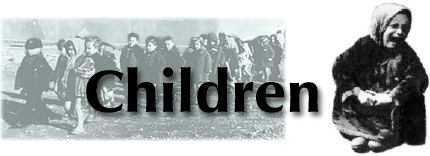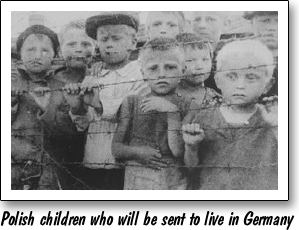
During the Holocaust, children were subjected to many injustices and cruelties. At first, Jewish and Gypsy children were restricted from going to school, and German children were taught that the Jews and Gypsies were racially inferior. One of the methods used to teach Gentile children about this inferiority was to have Jewish children come to the front of the classroom while the teacher pointed out their distinguishing features. Shortly, restrictions were placed on the Jews and later they were forbidden to go to German schools at all.
 Later, the Jews were forced to live in ghettos with their families. The conditions in these ghettos were very bad and children often risked their lives to smuggle food into the ghetto in order to help feed their families. Many children were left homeless in the ghettos as their parents were either killed or deported to concentration camps.
Later, the Jews were forced to live in ghettos with their families. The conditions in these ghettos were very bad and children often risked their lives to smuggle food into the ghetto in order to help feed their families. Many children were left homeless in the ghettos as their parents were either killed or deported to concentration camps.
Children were also deported to concentration camps where in some cases medical experiments were performed on them or they were subjected to slave labor. Some of the most notorious examples of experiments were performed by Josef Mengele who focused on children and adults who were twins and those with unusual features or handicaps.
United States Holocaust Memorial Museum: Children and the Holocaust outlines ways in which children were included in the Nazi persecution.
This site, Children of the Holocaust, gives accounts of individual children's
experiences during the Holocaust.
Children of the Holocaust: the Survivors Speak offers three stories of children
who survived the Holocaust.
Joseph Heinrich tells his story.
Descriptions of women who were children during the Holocaust.
French children of the Holocaust.
Mengele's Children: The Twins of Auschwitz.
"Non-Jewish Children in the Camps" by Sybil Milton.
Children in Hiding
Some Jewish children were forced to hide with their families in concealed closets, holes, or even sewers. Living under these conditions prevented children from experiencing their childhood because they had to stay quiet and still continuously for weeks or months. Some of these families received small amounts of food from people who knew where they were hiding.
 Other children hid their identities by living with Gentile families or traveling through the country and assuming Christian lives. Some children were able to conceal their identities because they blended in with the non-Jewish community. Sometimes they lived with Gentiles who didn't know that they were Jewish, and other times they lived in convents. Other children survived by working for short periods in villages and then moving on.
Other children hid their identities by living with Gentile families or traveling through the country and assuming Christian lives. Some children were able to conceal their identities because they blended in with the non-Jewish community. Sometimes they lived with Gentiles who didn't know that they were Jewish, and other times they lived in convents. Other children survived by working for short periods in villages and then moving on.
As a result of hiding, many children suffered from identity crises both during and after the war. When they were allowed to follow the Jewish faith again, many found it difficult to find their place either in the Christian or the Jewish religions.
Andrew Salamon was a child during the war and found many ways to disguise his real identity.
"Hidden Children" is a two part story that discusses physical and identity hiding.
"Between Two Religions" looks at the consequences of hiding Jewish children in Christian homes and institutions during the Holocaust.
Mia, Ab, and Wim Ikkersheim: Memories of Hidden Children.
Slave Labor
At the concentration camps, very young children and the elderly were immediately sent to the gas chambers. Older children and young adults were kept for slave labor. The conditions in these labor camps were deplorable including malnutrition, poor protection from the elements, and hard labor. The work that the people at the camps were forced into ranged from electrical work to carrying heavy stones for construction to burying the dead. The laborers were kept in the camps until they reached a point where they could no longer work at which time they were exterminated.
In order to survive these conditions, the young people in the camps formed very close ties with each other. Oftentimes they had become separated from their family members and developed new relationships within their barracks. Despite this tenuous support, all of these children suffered emotionally from the horrible conditions and treatment they endured and witnessed.
Kindertransport
Following Kristallnacht, the Night of the Broken Glass, on November 9, 1938, groups of children were transported to Britain for sanctuary via a program called "Kindertransport." Although all countries were asked to give aid to the Jewish children, only the United Kingdom agreed to help. One of the conditions of the chidren's transport to the UK was that the Nazis be paid 50 pounds sterling (approx. $250) per child. This fee was paid primarily by the residents of the UK rather than by the government. In addition, the children had to be between the ages of 3 and 17 and they had to leave Germany alone, without their parents. Ten thousand children were transported to the UK on trains via Holland. Only about 20% of these children were reunited with their families.
![]() Marietta Drücker tells her story of rescue from Vienna on a Kindertransport.
Marietta Drücker tells her story of rescue from Vienna on a Kindertransport.
![]() Helga Waldman tells her story of leaving Germany on a Kindertransport.
Helga Waldman tells her story of leaving Germany on a Kindertransport.
A brief history of the Kindertransports is located at the Kindertransport Association Web site.
"Into the Arms of Strangers," stories of the Kindertransport.
The story of Paul M. Cohn who traveled from Hamburg to England on a Kindertransport.
Nobel prize laureate Walter Kohn escaped Austria on a Kindertransport just three weeks before World War II began.
 Lebensborn
Lebensborn
In an effort to keep the German race "pure," Heinrich Himmler began a program called "Lebensborn," Spring of Life. This program encouraged German women who fit the Aryan profile to have children with SS officers. The children were born in homes maintained specifically for this purpose. Initially, these homes were designed for the mothers to have their children, but they later developed into places for prospective mothers to meet SS officers who were to become fathers.
One phase of Lebensborn involved the kidnapping of children from other countries who fit the racially pure profile and transforming them into Nazis. Many of the kidnapped children did not survive this ordeal because after medical examinations they were determined to be insufficiently pure. As a result, these children were exterminated. It is believed that only ten percent of the kidnapped children were reunited with their families following the war.
The Lebensborn page at the Forgotten Camps Web site.
Hitler Youth
The Nazi party actively recruited German children to become part of the Hitler Youth. At first the group was quite small, but once Hitler became Chancellor in 1933, the group began to grow.
In the beginning, the Hitler Youth consisted of boys who, once they reached the age of 18, were expected to join the Nazi party. In 1933, Baldur von Shirach restructured the group allowing boys between the ages of 6 and 10 to engage in activities with the older boys who were part of the Jungvolk (10-14 year-olds) or the Hitler Jugend, Hitler Youth (14-18 year-olds).
Although the boys' groups were the largest, two girls' groups, Jungmadel for 10-14 year-olds and Bund Deutcher Madel for 14-18 year-olds, were also established. The girls were taught typical roles such as raising children and working in the home. In addition, they worked as nurses for those who were injured during the war.
The training that the youth went through was very intense and included paramilitary training. The boys' sports included games that often ended in fights which were encouraged by their leaders. In 1936 Hitler made it mandatory for all children from the age of 10 to become members of the Hitler Youth. The following year the group began training the boys in the use of rifles. The boys, and later girls, were sent to fight for the Reich. In 1945 American soldiers reported fighting against entire units of Germans comprised of soldiers twelve years old and younger. Once these children were sent into combat, they often fought to the death. A famous film, poignantly representing Germany in its final hours, is of a stumbling old Hitler decorating twelve-year old Nazi youth with iron crosses during the battle for Berlin.
The History Place describes the history of Hitler Youth.
This Nazi document describes how Hitler Youth speakers promoted the growth of the group.
Examples of Nazi propaganda used to attract young people to the Nazi Party.
Lesson plans, discussion questions, term paper topics, reproducible handouts, and other resources for teaching about children are available here.
| Victims | Perpetrators | Bystanders | Resisters | Rescuers | Liberators | Survivors | Children |
A Teacher's Guide to the Holocaust
Produced by the Florida Center for Instructional Technology,
College of Education, University of South Florida © 1997-2013.